
Ipomoea tricolor, the Mexican morning glory or just morning glory, is a species of flowering plant in the family Convolvulaceae, native to the New World tropics, and widely cultivated and naturalised elsewhere. It is an herbaceous annual or perennial twining liana growing to 2–4 m (7–13 ft) tall. The leaves are spirally arranged, 3–7 cm long with a 1.5–6 cm long petiole. The flowers are trumpet-shaped, 4–9 cm (2–4 in) in diameter, most commonly blue with a white to golden yellow centre.

Ipomoea aquatica is a semi-aquatic, tropical plant grown as a vegetable for its tender shoots and it is not known as to where it originated. This plant is known in English as water spinach, river spinach, water morning glory, water convolvulus, or by the more ambiguous names Chinese spinach, Chinese watercress, Chinese convolvulus or swamp cabbage, or kangkong in Southeast Asia and ong choy in Cantonese.

Ipomoea alba, sometimes called the tropical white morning-glory or moonflower or moon vine, is a species of night-blooming morning glory, native to tropical and subtropical regions of North and South America, from Argentina to northern Mexico, Florida and Puerto Rico. Though formerly classified as genus Calonyction, species aculeatum, it is now properly assigned to genus Ipomoea, subgenus Quamoclit, section Calonyction.
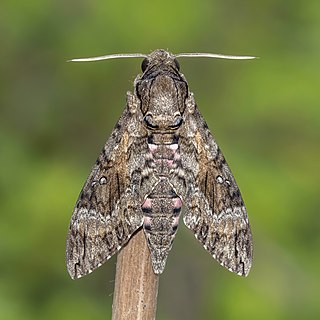
Agrius cingulata, the pink-spotted hawkmoth or sweetpotato hornworm, is a moth in the family Sphingidae. The species was first described by Johan Christian Fabricius in 1775.

Ipomoea cairica is a vining, herbaceous, perennial plant with palmate leaves and large, showy white to lavender flowers. A species of morning glory, it has many common names, including mile-a-minute vine, Messina creeper, Cairo morning glory, coast morning glory and railroad creeper.
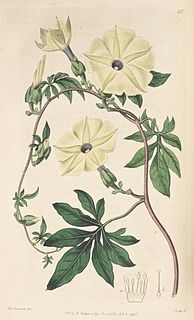
Ipomoea tuberculata is a flowering plant species in the bindweed family (Convolvulaceae). It belongs to the morning glory genus, Ipomoea.
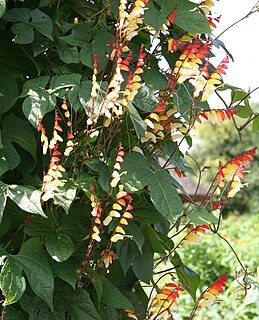
Ipomoea lobata, the fire vine, firecracker vine or Spanish flag, is a species of flowering plant in the family Convolvulaceae, native to Mexico and Brazil.

Ipomoea indica is a species of flowering plant in the family Convolvulaceae, known by several common names, including blue morning glory, oceanblue morning glory, koali awa, and blue dawn flower. It bears heart-shaped or 3-lobed leaves and purple or blue funnel-shaped flowers 6–8 cm (2–3 in) in diameter, from spring to autumn. The flowers produced by the plant are hermaphroditic.

Ipomoea pandurata, known as man of the earth, wild potato vine, manroot, wild sweet potato, and wild rhubarb, is a species of herbaceous perennial vine native to North America. It is a twining plant of woodland verges and rough places with heart-shaped leaves and funnel-shaped white flowers with a pinkish throat. The large tuberous roots can be roasted and eaten, or can be used to make a poultice or infusion. When uncooked, the roots have purgative properties.

Ipomoea hederacea, the ivy-leaved morning glory, is a flowering plant in the bindweed family. The species is native to tropical parts of the Americas, and has more recently been introduced to North America. It now occurs there from Arizona to Florida and north to Ontario and North Dakota. Like most members of the family, it is a climbing vine with alternate leaves on twining stems. The flowers are blue to rose-purple with a white inner throat and emerge in summer and continue until late fall. The leaves are typically three-lobed, but sometimes may be five-lobed or entire. Flowers occur in clusters of one to three and are 2.5-4.5 cm long and wide. The sepals taper to long, recurved tips and measure 12–24 mm long. The species shares some features with the close relative Ipomoea purpurea.

Ipomoea nil is a species of Ipomoea morning glory known by several common names, including picotee morning glory, ivy morning glory, and Japanese morning glory. It is native to most of the tropical world, and has been introduced widely.
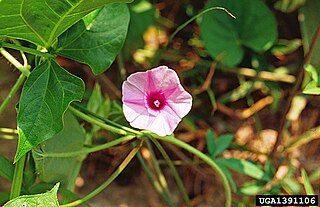
Ipomoea heptaphylla, sometimes known as Wright's morning glory in the United States, is a species of morning glory. It is incorrectly classified as I. wrightii in American publications, but is incorrectly known as I. tenuipes in Africa and India. It is an annual or short-lived perennial vine which climbs using twining stems, and has pink or purple flowers. The leaf shape is somewhat variable, with individuals possessing compound leaves palmately divided into five leaflets, and lanceolate-leaved individuals occurring in neighbouring populations. The name heptaphylla actually means 'seven-leaved'. This plant has a very extensive distribution, from Texas and adjacent states in the southeastern USA to Misiones in northern Argentina, the Greater Antilles of the Caribbean, India, Sri Lanka and East and Southern Africa. Despite its wide distribution it is uncommon throughout its range. The rediscovery of the presence of the species in India after an absence of over half a century was published in 2014. The species appears to favour dry subtropical to tropical habitats.
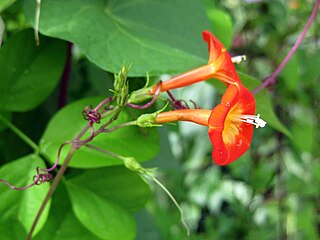
Ipomoea coccinea is a flowering plant in the family Convolvulaceae known by several common names including red morning glory, redstar and (ambiguously) Mexican morning glory.

Ipomoea lacunosa, the whitestar, white morning-glory or pitted morningglory, is a species that belongs to the genus Ipomoea. In this genus most members are commonly referred to as "morning glories". The name for the genus, Ipomoea, has root in the Greek words ips and homoios, which translates to worm-like. This is a reference to the plant's vine-like growth. Lacunosa comes from a Latin word meaning air spaces, correlating with the venation of the leaves. Ipomoea lacunosa is native to the United States and grows annually. The flowers of this species are usually white and smaller than most other morning glories.

Ipomoea simplex is a central and eastern Southern African grassland species of Convolvulaceae or Sweet Potato family, notable for its large tuber or root, often eaten raw by Xhosa and Sotho herd boys. Carl Peter Thunberg first described this species in the Prodromus Plantarum Capensium of 1794. 'Ipomoea' = 'worm-like', in reference to the twining habit of the genus.
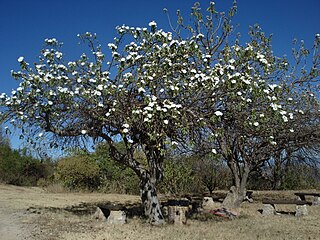
Ipomoea arborescens, the tree morning glory, is a flowering plant coming from the family Convolvulaceae. It grows fast and produces semi succulent stems. This tropical plant is mostly found in Mexico. It flowers in late autumn and winter. Its common name in Nahuatl is Cazahuatl or Cazahuate.
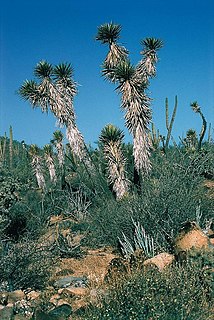
Yucca valida is a plant species in the family Asparagaceae, native to the Mexican states of Baja California, Baja California Sur, Sonora, and Sinaloa. The common name is datilillo.

Ipomoea oenotherae is a species of plant of the morning glory genus, Ipomoea, in the family Convolvulaceae. It derives its name from the resemblance it bears to plants in the genus Oenothera. Ipomoea oenotherae is a succulent and a cryptophyte.

Ipomoea pes-tigridis is a species of Ipomoea and family Convolvulaceae. It is known as tiger's footprint. The species is distributed in Asia, Africa, Australia and other islands in the Pacific. It grows in roadsides and sea coasts which sea level is between 0 and 400 m.

Ipomoea imperati, the beach morning-glory, is a species of flowering plant in the family Convolvulaceae. Like Ipomoea pes-caprae, its seeds disperse by floating in seawater. It has been found on the sandy shores of every continent except Antarctica.




















